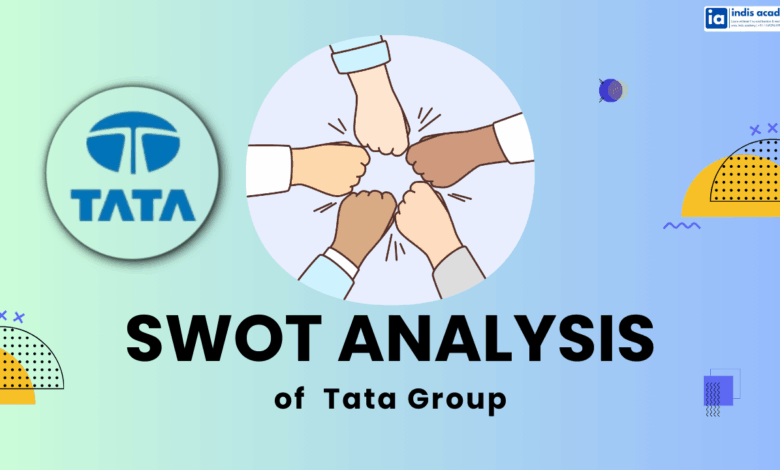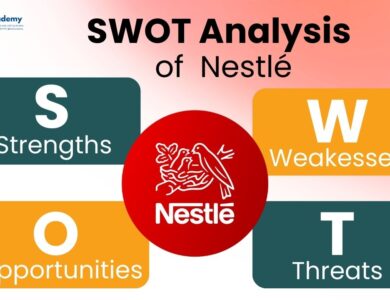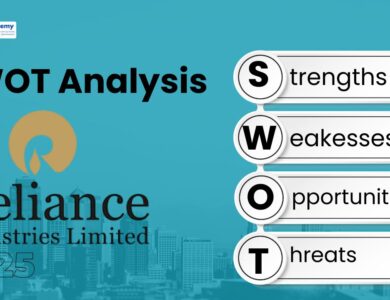SWOT Analysis of Tata Group: Strength, Legacy & Future Strategy
Explore the complete SWOT analysis of Tata Group in 2025. Discover how India’s most respected conglomerate balances its industrial legacy with modern innovation across steel, IT, retail, EVs, and more.

When you think of trust in Indian business, one name stands tall—Tata Group.
Founded in 1868 by Jamsetji Tata, the Tata Group is not just a business empire; it’s a symbol of nation-building, ethics, and innovation. From building India’s first steel plant and launching its first indigenous car, to running the country’s largest IT company—Tata’s journey is deeply intertwined with India’s industrial growth.
Fast-forward to 2025, Tata is at the forefront of electric vehicles, digital transformation, clean energy, and global tech services, while still rooted in traditional industries like steel and chemicals.
But with the business world evolving rapidly, how is the group navigating competition from agile conglomerates like Reliance and Adani, rising consumer expectations, and global tech shifts?
In this article, we’ll analyze the Strengths, Weaknesses, Opportunities, and Threats of the Tata Group in 2025 to uncover what keeps it strong—and what it must do to stay ahead.
Learn AI & Digital Marketing,
Pay Fees After Placement
- ✅ Minimal Admission Fees
- ✅ No Loan or Income Sharing Agreement
- ✅ 100% Placement Support
- ✅ ISO & Govt Registered Certificate
- ✅ Practical 3+1 Months Duration
Get a free counseling call. We’ll guide you through learning, certification, and job placement.
Request a Free Call Back
Takes less than a minute.
Company Overview of Tata Group
The Tata Group is India’s most respected and globally recognized business conglomerate, founded by Jamsetji Tata in 1868. It operates under the parent company Tata Sons, with over 100 subsidiaries and associate firms spread across diverse industries.
As of 2025, Tata Group operates in more than 100 countries, employing over 900,000 people and generating combined annual revenues exceeding ₹10 lakh crore ($120+ billion).
Key Tata Group Companies:
- Tata Consultancy Services (TCS): One of the world’s top IT services firms
- Tata Motors: India’s leading EV and automobile manufacturer
- Tata Steel: Among the world’s most geographically diversified steel producers
- Titan Company: Leader in watches, jewelry, eyewear
- Tata Power: Major player in conventional and renewable energy
- Tata Consumer Products: Owner of Tata Tea, Tata Salt, Tata Sampann
- Taj Hotels (IHCL): Iconic hospitality brand
- Air India: Now under Tata’s control, post-acquisition
Tata Group’s strength lies in its diversified portfolio, commitment to nation-first values, and the backing of Tata Trusts, which owns 66% of Tata Sons—making the group as focused on philanthropy as on profits.
What is a SWOT Analysis?
A SWOT analysis is a strategic framework used to evaluate a company’s position by identifying four key dimensions:
- Strengths – Internal advantages that drive competitive edge
- Weaknesses – Internal limitations that could hinder growth
- Opportunities – External trends or market shifts the company can leverage
- Threats – External risks that could impact performance
For a massive and diversified group like Tata, a SWOT analysis helps assess how well it balances legacy industries with modern innovation—especially in 2025, where sectors like electric vehicles, AI, clean energy, and digital commerce are evolving rapidly.
Understanding Tata’s SWOT gives insight into how India’s most admired conglomerate is preparing for the next century of growth, both in India and abroad.
Strengths of Tata Group
The Tata Group stands out not just for its size, but for its deep ethical foundation, diversified presence, and ability to evolve across centuries. In 2025, its strengths are more relevant than ever—especially in a global economy demanding trust, resilience, and sustainability.
Let’s explore the key strengths that power the Tata Group today:
1. Legacy of Trust & Ethical Governance
Tata is consistently ranked as one of India’s most trusted brands. Its focus on corporate integrity, community development, and long-term vision gives it unmatched credibility among consumers, employees, and investors.
2. Diversified Portfolio Across Core & Growth Sectors
From steel to software, energy to EVs, salt to startups, Tata’s balanced portfolio reduces risk and creates cross-sector synergies:
- TCS dominates global IT
- Tata Motors leads India’s EV race
- Tata Power is expanding its clean energy grid
- Tata Consumer & Titan are gaining strong ground in lifestyle FMCG
3. Global Reach with Indian Heart
Operating in 100+ countries, Tata has built international credibility while remaining deeply rooted in India. Brands like Taj Hotels, Jaguar Land Rover, TCS, and Tetley Tea are globally recognized.
4. Strong R&D, Tech & Sustainability Initiatives
Tata invests heavily in:
- EV R&D and battery innovation
- AI and cloud services (TCS)
- Hydrogen fuel and solar (Tata Power)
- Sustainable steel (Tata Steel’s green steel plans)
5. Tata Trusts & Purpose-Driven Model
66% of Tata Sons is owned by Tata Trusts, enabling the group to fund education, healthcare, and social welfare at scale—reinforcing its purpose-over-profit identity.
Competitor Snapshot – 2025 Overview
| Group | Core Sectors | FY25 Revenue (Est.) | ESG Focus | Global Footprint |
|---|---|---|---|---|
| Tata Group | Steel, IT, Auto, Energy, FMCG | ₹10+ lakh crore | Strong | Very Strong |
| Reliance | Energy, Retail, Telecom, Green Tech | ₹10+ lakh crore | Medium | Medium |
| Adani Group | Infra, Energy, Logistics, Data | ₹3.5–4 lakh crore | Emerging | Growing |
| Mahindra Group | Auto, Agri, Finance, IT | ₹1.2–1.5 lakh crore | Strong | Medium |
Weaknesses of Tata Group
While the Tata Group enjoys tremendous goodwill and industrial strength, its size, structure, and legacy dependencies bring certain internal challenges—especially in an era that rewards speed, digital agility, and sharper consumer focus.
Here are key weaknesses Tata faces in 2025:
1. Complex Conglomerate Structure
The group consists of 29+ publicly listed companies, many with overlapping operations and diverse management. This leads to:
- Slower decision-making
- Difficult capital allocation
- Coordination issues across business verticals
2. Underperforming & Legacy Businesses
Despite overall success, some Tata entities have struggled:
- Air India (before turnaround efforts)
- Tata Tele Services
- Tata Steel Europe (low margins, cyclical risks)
Maintaining loss-making or legacy verticals can dilute profitability and management focus.
3. Slow Consumer-Facing Brand Penetration
Compared to competitors like Reliance or HUL, Tata’s FMCG and retail verticals (Tata Consumer, Croma, Tata Neu) are still catching up in brand recall, modern UX, and digital engagement—especially with Gen Z.
4. Execution Risk in Mega Projects
EV platforms, green hydrogen plants, Air India transformation, and the Tata Neu super app are all capital-intensive bets. Poor integration, delays, or market misalignment could impact growth and investor confidence.
5. Conservative Marketing & Innovation Speed
While ethical and cautious, Tata often loses the first-mover advantage in disruptive sectors due to risk-averse brand positioning and conservative rollouts—especially in direct-to-consumer and youth-focused markets.
These weaknesses suggest Tata must now streamline operations, empower agile verticals, and accelerate digital innovation without compromising its core values.
Opportunities for Tata Group
In 2025, Tata Group is uniquely positioned to lead India’s next industrial and digital revolution—thanks to its multi-sector presence, consumer trust, and strong capital base. By investing in high-growth areas, Tata can shape the future of mobility, technology, energy, and consumer lifestyles.
Let’s explore key opportunities:
1. Scaling India’s EV Ecosystem
Through Tata Motors, Tata.ev, and Tata Power, the group can dominate:
- Electric car manufacturing
- Battery storage and charging infrastructure
- Two-wheeler and commercial EVs
Tata already leads EV sales in India and aims to become a complete EV ecosystem provider.
2. Expanding the Tata Digital Universe
With platforms like Tata Neu, 1mg (pharmacy), BigBasket (grocery), and Croma (electronics), Tata has laid the foundation for a multi-category super app. With better personalization, UX, and partnerships, it can become a top digital commerce destination.
3. Green Energy & Climate Tech
Tata Power is growing fast in:
- Solar rooftops and microgrids
- Wind energy and EV charging
- Green hydrogen and carbon capture (pilot stage)
Tata Steel is also investing in low-carbon steel and ESG-friendly manufacturing—positioning the group as a climate-forward industrial leader.
4. Premium Consumer Brands & FMCG Growth
Tata Consumer Products can expand further in:
- Health-focused foods (Tata Sampann)
- Plant-based beverages
- Ready-to-cook meals, breakfast, and wellness segments
This helps Tata tap into rising urban health and convenience trends.
5. Global Expansion in Tech & Hospitality
- TCS can scale AI, cloud, cybersecurity, and generative tech globally
- Taj Hotels (IHCL) can expand premium stays and heritage tourism
- Tata’s global presence and brand equity make cross-border growth smoother than most Indian peers
Tata’s future success depends on speed, synergy, and storytelling—turning its platform strengths into connected, global consumer and industrial ecosystems.
Threats to Tata Group
Despite its strong foundation, Tata Group faces several external challenges that could impact its pace of growth, profitability, or public perception—especially in sectors marked by disruption, global volatility, and rising competition.
Here are the top threats in 2025:
1. Aggressive Competition from Reliance & Adani
- Reliance is rapidly expanding in retail, EVs, and green energy, with deep capital access and faster execution.
- Adani Group is dominating infrastructure, logistics, renewables, and data center sectors.
Tata must move faster to maintain its leadership across future-facing industries.
2. Economic Slowdowns & Global Tech Pressure
Sectors like steel, auto, and IT services (TCS) are vulnerable to:
- Inflation and recession
- Global demand fluctuations
- Pricing pressure from Western tech clients
A weak global economy could strain Tata’s diversified portfolio.
3. Regulatory & Policy Complexity
With businesses across energy, aviation, telecom, banking, and infrastructure, Tata faces:
- Cross-industry regulatory compliance
- Frequent tax, labor, and environmental law changes
- Geo-political tensions impacting imports, exports, and acquisitions
4. Digital Disruption in Consumer Behavior
Consumers now prefer:
- D2C brands with quick innovation
- Hyper-personalized shopping experiences
- Mobile-first, voice-assisted platforms
Tata’s traditional approach may limit its appeal to digitally native Gen Z audiences unless it modernizes aggressively.
5. Integration Risk in Acquisitions
Large acquisitions like Air India, BigBasket, and 1mg demand major integration efforts. Delays or poor customer experiences could harm brand perception and profitability.
To thrive, Tata must stay agile, accelerate innovation, and build consumer-first, tech-powered ecosystems—while defending its industrial legacy from leaner, faster rivals.
Strategic Insights & Key Takeaways
The Tata Group stands as a rare example of legacy-led innovation—balancing social purpose with business scale. But in 2025, success hinges not just on history, but on speed, synergy, and smart execution.
Here’s what the SWOT analysis reveals:
- Strengths like trust, ethical leadership, and diversified dominance make Tata resilient in volatile markets.
- Weaknesses such as complex structure and underperforming units must be addressed to sharpen execution.
- Opportunities in EVs, green energy, digital retail, and global tech create enormous growth potential—if scaled with agility.
- Threats from disruptive rivals, economic instability, and consumer behavior shifts require fast, future-ready adaptation.
The Tata Group’s next leap will depend on how well it can simplify operations, innovate like a startup, and build consumer ecosystems powered by trust and technology.
Conclusion
The Tata Group is not just a business empire—it’s a symbol of India’s industrial, ethical, and social evolution. From building steel plants to software systems, from running airlines to electric vehicles, Tata has consistently shaped India’s growth story.
But in 2025, legacy alone won’t lead the way.
To remain ahead, Tata must evolve with the world: faster in innovation, bolder in digital strategy, and sharper in customer experience. If it can turn its vast presence into connected value—while staying rooted in its purpose—it won’t just lead India’s future. It will help define it.
❓ FAQs – SWOT Analysis of Tata Group
1. What are the most successful Tata companies?
Top performers include Tata Consultancy Services (TCS), Tata Motors, Tata Steel, Titan, Tata Power, and Taj Hotels—each leading in their sectors.
2. What is Tata Neu, and how is it performing?
Tata Neu is the group’s super app combining grocery (BigBasket), electronics (Croma), healthcare (1mg), and flights (Air India). It’s still maturing and faces UX and loyalty challenges.
3. Is Tata a major player in the EV space?
Yes. Tata Motors is the largest EV seller in India, and the group is investing in battery tech, EV infra, and green mobility under the Tata.ev brand.
4. How does Tata compare to Reliance and Adani?
Tata is known for ethical governance, diverse strength, and stability. Reliance is faster in digital and retail, while Adani dominates infra and logistics. Tata’s edge lies in trust and balanced growth.
5. Is Tata foc used on sustainability?
Absolutely. Tata Power and Tata Steel are investing in renewables, green hydrogen, and low-carbon manufacturing, making Tata a leader in India’s clean energy transition.
Related Articles





